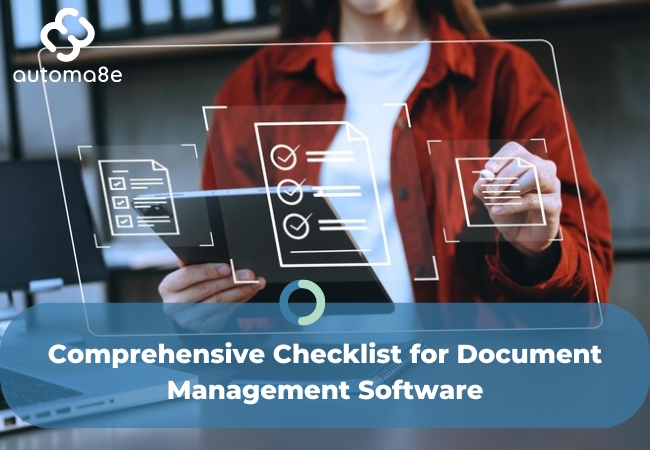In today’s rapidly evolving digital landscape, the management of documents and data has become paramount for organizations across all industries. Central to this endeavor is the deployment of robust document processing software that not only ensures the security of sensitive information but also enhances user accessibility and operational efficiency. From stringent security protocols to seamless integration with existing IT infrastructure, the criteria for selecting the right document processing solution are multifaceted and crucial for organizational success. By prioritizing key aspects such as security, user experience, and scalability, businesses can pave the way for optimized workflows and streamlined operations.
Security:
- Ensure documents and data are securely captured, processed, and stored.
- Implement robust encryption algorithms to safeguard sensitive information during all stages.
- Utilize secure authentication methods to control access and prevent unauthorized entry.
- Regularly audit and update security protocols to address emerging threats and vulnerabilities.
Rights Structures for User Access Control:
- Establish comprehensive user roles and permissions to control document access.
- Differentiate between read, write, and edit permissions based on user responsibilities.
- Implement multi-factor authentication for enhanced user identity verification.
Data Separation:
- Separate back-end system data from customer-facing data to fortify protection.
- Employ network segmentation to isolate critical databases and sensitive information.
- Utilize role-based access controls to restrict access to specific user groups.
Redundancy and Encryption:
- Embrace redundancy measures to ensure data availability in case of system failures.
- Implement encryption at rest and in transit to secure data both during storage and transmission.
- Regularly test and update encryption protocols to meet evolving security standards.
Ease of Use:
- Minimize clicks and streamline processes for user efficiency.
- Implement intuitive user interfaces with clear navigation and minimalistic design.
- Provide comprehensive training resources and user guides for quick adoption.
Adoption Times and Learning Curves:
- Focus on short adoption times by simplifying onboarding processes.
- Offer interactive tutorials and walkthroughs to accelerate user learning curves.
- Utilize Customer Experience Improvement Programs (CEIP) to gather user feedback for continuous enhancement.
Capture Capabilities:
- Automate scanning and data collection processes.
- Implement advanced Optical Character Recognition (OCR) for accurate data extraction.
- Integrate machine learning-based capture solutions like DocuWare Intelligent Indexing for enhanced document understanding.
- Utilize web-based forms to offer flexible and efficient data collection options.
Workflow Automation:
- Automate business processes through intuitive visual design.
- Enable drag-and-drop functionality for easy workflow creation.
- Provide options for task management, decision-making, and sequential or parallel task organization.
Electronic Signature:
- Integrate electronic signatures seamlessly into workflows.
- Ensure compliance by enabling digital signatures from verified Trust Service Providers.
- Implement version control mechanisms and maintain an audit trail for regulatory requirements.
Scalable Architecture:
- Facilitate growth without impacting performance or retraining.
- Choose a modular and scalable system architecture capable of handling increasing document volumes.
- Opt for cloud-based solutions to leverage additional scalability benefits.
Integration:
- Ensure seamless integration with other software in your IT infrastructure.
- Enable functionalities like database synchronization, mail server import, and external user administration.
- Utilize Application Programming Interfaces (APIs) for smooth communication between systems.
Support for a Hybrid Workforce:
- Embrace cloud-based solutions for streamlined remote work.
- Address security and compliance challenges associated with a remote workforce.
- Implement secure access controls and VPN solutions for remote document processing.
Email Equality:
- Treat email as a crucial business document.
- Implement archiving solutions for emails to ensure accessibility and compliance.
- Integrate emails seamlessly into business processes for streamlined communication.
Mobile Capabilities:
- Provide mobile access to documents and workflows.
- Develop responsive mobile interfaces for document processing applications.
- Ensure real-time collaboration and task management features for on-the-go employees.
By prioritizing these comprehensive criteria, organizations can identify a document management solution that not only meets their immediate needs but also establishes a foundation for enhanced security, usability, and integration with other essential software. Focus on these fundamentals to experience significant cost savings and increased operational efficiency, propelling your organization forward.
In conclusion, the adoption of comprehensive document processing software stands as a cornerstone for modern businesses aiming to thrive in an increasingly competitive environment. By adhering to the outlined criteria encompassing security, user access control, data separation, and mobile capabilities, organizations can empower their workforce with efficient tools while safeguarding critical information assets. Through a strategic focus on these fundamental elements, businesses can not only achieve cost savings and operational efficiencies but also establish a resilient foundation for future growth and innovation. Embracing the transformative potential of document processing solutions, organizations can navigate the complexities of the digital age with confidence and agility.
